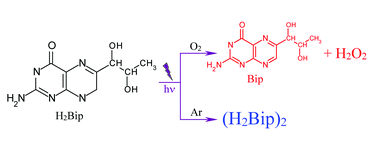Photochemistry of dihydrobiopterin in aqueous solution†
Abstract

* Corresponding authors
a
Instituto de Investigaciones Fisicoquímicas Teóricas y Aplicadas (INIFTA), Departamento de Química, Facultad de Ciencias Exactas, Universidad Nacional de La Plata, CCT La Plata-CONICET, Casilla de Correo 16, Sucursal 4, (1900) La Plata, Argentina
E-mail:
athomas@inifta.unlp.edu.ar
b CIHIDECAR - CONICET, Departamento de Química Orgánica, Facultad de Ciencias Exactas y Naturales, Universidad de Buenos Aires, Pabellón 2, 3p, Ciudad Universitaria, 1428 - Buenos Aires, Argentina
c Service Commun de Spectrométrie de Masse (FR2599), Université de Toulouse (Paul Sabatier), 118, route de Narbonne, F-31062 Toulouse cédex 9, France
d CNRS, LCC (Laboratoire de Chimie de Coordination), 205, route de Narbonne, Toulouse, France
e
Laboratoire des IMRCP, UMR CNRS 5623, Université de Toulouse (Paul Sabatier), 118, route de Narbonne, Toulouse cédex 9, France
E-mail:
oliveros@chimie.ups-tlse.fr

 Please wait while we load your content...
Something went wrong. Try again?
Please wait while we load your content...
Something went wrong. Try again?
M. Vignoni, F. M. Cabrerizo, C. Lorente, C. Claparols, E. Oliveros and A. H. Thomas, Org. Biomol. Chem., 2010, 8, 800 DOI: 10.1039/B913095K
To request permission to reproduce material from this article, please go to the Copyright Clearance Center request page.
If you are an author contributing to an RSC publication, you do not need to request permission provided correct acknowledgement is given.
If you are the author of this article, you do not need to request permission to reproduce figures and diagrams provided correct acknowledgement is given. If you want to reproduce the whole article in a third-party publication (excluding your thesis/dissertation for which permission is not required) please go to the Copyright Clearance Center request page.
Read more about how to correctly acknowledge RSC content.
 Fetching data from CrossRef.
Fetching data from CrossRef.
This may take some time to load.
Loading related content
